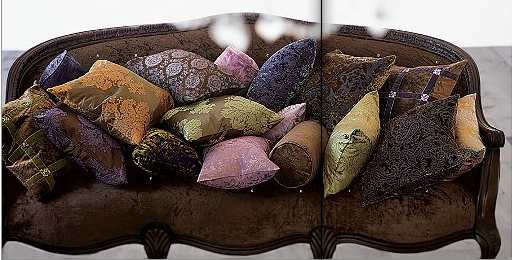Brocades
Hong Kong was a classified British territory from the 1980s until 1997 when it was “given back” to its home country of China. Around this time, oriental influences arose throughout fashion culture including in the implementation of rich brocade textiles into home design.

Polyester & "Unnatural" Fabrics
Once seen as bad substitutes to natural fabrics, man-made fibers became much more prevalent in the 1990s. Sheer curtains made from polyester became popular as well as home accents made of environmentally-conscious fabrics made from recycled plastic bottles and cork. Ultrasuede, the world's first micro-fiber, was another commonly used household textile as it looks and feels like suede but is in fact 100% polyester. This means that it is stain resistant unlike natural suede and can even be washed in a washing machine.
Leather and Suede furniture
Leather is made primarily from cowhide and was a popular choice for home furnishings in the 1990s as it is very strong, durable and color-fade resistant. Also, leather is seen as a kid-friendly fabric as it has a finish that repels moisture and is thus easy to clean.

Another popular trend in home textiles was the use of apparel textiles on furniture. This was to add the element of comfort and elegance to homes that clothing was providing to its wearer. For example: reupholstering a faded couch in jersey knit, velvet, cashmere, nylon, etc. As Wayne Nathan, a designer with Ms. Hagan put it, ''It lends a room a different kind of formality, one that's not so commercial.''
 A fabulous couch upholstered in violet velvet
A fabulous couch upholstered in violet velvet
Sources
http://www.hometonic.com/a-leatherbenefits.html
http://www.fashion-era.com/the_1990s.htm
Picture Sources
http://www.ourfixerupper.com/wp-content/uploads/2007/01/couch.bmp
http://www.made-in-china.com/image/2f0j00RBeTfLDyJHcIM/Voile-Polyester-Curtain.jpg
http://ecotiques.com/ecoshop/images/naturalcork.jpg
http://www.ameriglobe.net/products/DS-167.html
http://www.cleaningcarpets.co.nz/leather.php
http://www.voguefabricsstore.com/store/catalog/Ultra-Suede-Coffee-Cream-p-5807.html




Customizing fabric is a skill that gives ordinary fabrics an extraordinary appeal. A somewhat bland fabric can now be transformed with just a little bit of paint and or accessories. Even if your style is more on the conservative side, having an item customized can add a unique twist to your design. Creating stunning patterns for fabric painting can be the vital element in making your designs pop.
ReplyDeleterobert allen fabrics